Serum 25-hydroxyvitamin-D level and atopic dermatitis severity in children
Abstract
Background Vitamin D plays an important role in the immune system. It inhibits B-lymphocyte proliferation and modulates the humoral response to suppress IgE production. Studies on the relationship between serum 25-hydroxyvitamin-D level and the severity of atopic dermatitis in several countries have had varying results.
Objective To assess for a possible correlation between serum 25-hydroxyvitamin-D level and atopic dermatitis severity in children.
Methods A cross-sectional study was conducted in 26 children with atopic dermatitis from September to December 2015. We evaluated the severity of disease using the Scoring of Atopic Dermatitis (SCORAD) index and measured serum 25-hydroxyvitamin-D levels. Spearman’s test was used to analyze for a correlation between serum 25-hydroxyvitamin-D level and the atopic dermatitis  score in children with atopic dermatitis.
Results Mean SCORAD index was 32.0 (SD 14.99) , with a range of 10.9 to 71.4. Mean serum 25-hydroxyvitamin-D level was 41.1 (SD 24.81) ng/mL, with a range of 10-137 ng/mL. There was a moderate correlation between serum 25-hydroxyvitamin-D level and the SCORAD index (r=-0.591), with higher SCORAD index associated with lower serum 25-hydroxyvitamin-D level (P=0.01).
Conclusion There is a moderate correlation between serum 25-hydroxyvitamin-D level and the SCORAD index in children with atopic dermatitis.
References
2. Cantani A. Atopic dermatitis. In: Cantani A. Pediatric Allergy, Asthma and Immunology. Berlin: Springer; 2010. p. 473-5.
3. Watson W, Kapur S. Atopic dermatitis. Allergy Asthma Clin Immunol. 2011;7:S4.
4. Hanifin JM, Rajka G. Diagnostic feature of atopic dermatitis. Acta Dermatovener (Stockholm). 1980;92:44-7
5. Oranje AP, Glazenburg EJ, Wolkerstorfer A, de Waard-van der Spek FB. Practical issues on interpretation of scoring atopic dermatitis: the SCORAD index, objective SCORAD and the three-item severity score. Br J Dermatol. 2007;157:645-8.
6. Vassallo MF, Camargo CA. Potential mechanisms for the hypothesized link between sunshine, vitamin D, and food allergy in children. J Allergy Clin Immunol. 2010;126:217-22.
7. Muehleisen B, Gallo RL. Vitamin D in allergic disease. J Allergy Clin Immunol. 2013;131:324-9.
8. Holik MF. Vitamin D deficiency. N Engl J Med. 2007;357:266-81.
9. Benson AA, Toh JA, Vernon N, Jariwala SP. The role of vitamin D in the immunopathogenesis of allergic skin diseases. Allergy. 2012;67:296-301.
10. Peroni DG, Piacentini GL, Carmetti E, Chinellato I, Boner AL. Correlation between serum 25-hydroxyvitamin D levels and severity of atopic dermatitis in children. Br J Dermatol. 2011;164:1078-82.
11. Wang SS, Hon KL, Kong AP, Pong HN, Wong GW, Leung TF. Vitamin D deficiency is associated with diagnosis and severity of childhood atopic dermatitis. Pediatr Allergy Immunol. 2014;25:30-5
12. Hypponen E, Berry DJ, Wjst M, Power C. Serum 25-hydroxyvitamin D and IgE – a significant but nonlinear relationship. Allergy. 2009;64:613-20.
13. European Task Force on Atopic Dermatitis. Severity scoring of atopic dermatitis: the SCORAD Index (consensus report of the European Task Force on Atopic Dermatitis). Dermatology 1993;186:23–31
14. Holt PG. Programming for responsiveness to environtmental antigensthat trigger allergic respiratory disease in adulthood is initiated during the perinatal period. Environ Health perspect. 1998;3:795-800
15. Osman M. Therapeutic implication of sex differences in asthma and atopy. Arch Dis Child. 2003;88:587-90.
16. Strachan DP. Hay fever, hygiene, and household size. BMJ.1989;299:1259–60
17. Strachan DP. Family size, infection and atopy: the first decade of the “hygiene hypothesisâ€. Thorax. 2000;55(Suppl 1):s2-10
18. Weninggalih E, Kartasasmita CB, Setiabudiawan B. Hubungan antara atopi dengan riwayat penyakit alergi dalam keluarga dan manifestasi penyakit alergi pada balita. [cited 2016 March 29]; Available from: journal.fk.unpad.ac.id/index.php/mkb/article/viewFile/258/pdf_117
19. Javabakht MH, Keshavarz SA, Keshavarz SA, Djalali M, Siassi F, Eshraghian MR, et all. Randomized controlled trial using vitamin E and vitamin D supplementation in atopic Dermatitis. Journal of dermatological treatment.2011,144-50
20. Sidbury R, Sullivan AF, Thadhani RI, Camargo CA. Randomized controlled trial of vitamin D supplementation for winter-related atopic dermatitis in Boston: a pilot study. The Br J Dermatol.2008;159:245-7.
Authors who publish with this journal agree to the following terms:
Authors retain copyright and grant the journal right of first publication with the work simultaneously licensed under a Creative Commons Attribution License that allows others to share the work with an acknowledgement of the work's authorship and initial publication in this journal.
Authors are able to enter into separate, additional contractual arrangements for the non-exclusive distribution of the journal's published version of the work (e.g., post it to an institutional repository or publish it in a book), with an acknowledgement of its initial publication in this journal.
Accepted 2017-10-16
Published 2018-01-05













